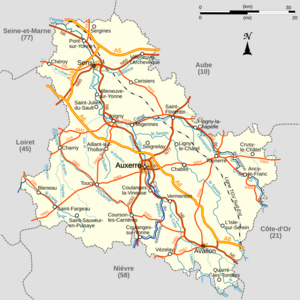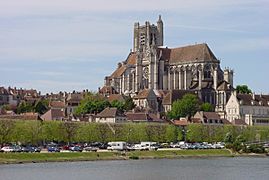Yonne facts for kids
Quick facts for kids
Yonne
|
|||
|---|---|---|---|
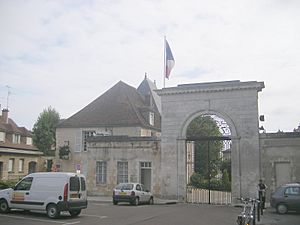
Prefecture building of the Yonne department, in Auxerre.
|
|||
|
|||
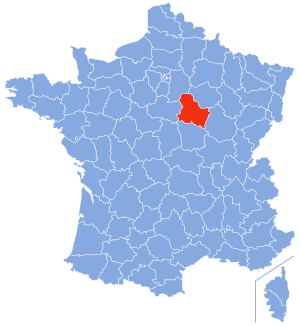
Yonne in France
|
|||
| Country | France | ||
| Region | Bourgogne-Franche-Comté | ||
| Département | 4 March 1790 | ||
| Prefecture | Auxerre | ||
| Subprefectures | Avallon, Sens | ||
| Area | |||
| • Total | 7,427.4 km2 (2,867.7 sq mi) | ||
| Population
(2014)
|
|||
| • Total | 341,814 | ||
| • Density | 46.0207/km2 (119.1930/sq mi) | ||
| Demonym(s) | Icaunais | ||
| Time zone | UTC+1 (CET) | ||
| • Summer (DST) | UTC+2 (CEST) | ||
| ISO 3166 code | FR-89 | ||
| Arrondissements | 3 | ||
| Cantons | 21 | ||
| Communes | 428 | ||
| Website | www.cg89.fr | ||
Yonne is a department located in the middle of France. It is part of the Bourgogne-Franche-Comté region. The biggest city in Yonne is Auxerre, which is also its capital.
The department gets its name from the Yonne river. This river is a tributary of the Seine river and flows right through the department. Long ago, the Celts called the river Ica-onna. This old name is where the river's name comes from, and it also gives the people living in the department their name: Icaunais.
Contents
History of Yonne
Early History: Roman Times
During the time of the Roman Empire, a very important city in this area was Sens. Sens was the capital of a Roman province.
Creating the Department
Yonne was one of the first 83 departments created during the French Revolution. This happened on March 4, 1790. Auxerre was chosen as its capital from the start. The department was formed by combining parts of three older provinces: Burgundy, Champagne, and Île-de-France.
Changes Over Time
When Yonne was first created, it was split into seven smaller areas called districts. These were Auxerre, Sens, Joigny, Saint-Fargeau, Avallon, Tonnerre, and Saint-Florentin.
In 1800, France created new administrative areas called arrondissements. The seven districts in Yonne were changed into five arrondissements: Auxerre, Avallon, Joigny, Sens, and Tonnerre. Later, on September 10, 1926, the arrondissements of Joigny and Tonnerre were removed.
Geography of Yonne
Yonne is located in the Bourgogne-Franche-Comté region. It covers an area of about 7,427 square kilometers (2,868 square miles). The highest point in the department is Bois de la Pérouse, which is 607 meters (1,991 feet) high.
Neighboring Departments
Yonne shares its borders with five other departments. These departments are in four different regions of France:
- In the Bourgogne-Franche-Comté region:
- In the Grand Est region:
- Aube to the northeast
- In the Centre-Val de Loire region:
- Loiret to the west
- In the Île-de-France region:
- Seine-et-Marne to the northwest
 |
Seine-et-Marne | Aube |  |
|
| Loiret | Côte-d'Or | |||
| Nièvre |
Landscape and Rivers
The northern part of Yonne is mostly flat plains. These plains are part of the larger plain of Paris. In the southern half of the department, you will find the mountains of the Morvan and the hills of the Auxerrois. The Auxerrois is the area around the city of Auxerre.
The most important river in the department is the Yonne river. It flows from the south to the north and eventually joins the Seine river. Other rivers that flow through Yonne include the Armançon, Loing, Ouanne, and Serein rivers.
Climate in Yonne
The climate in Auxerre, the capital of Yonne, is an "Oceanic climate." This means it has mild temperatures and rainfall throughout the year.
The average temperature in Auxerre for the whole year is about 11.5°C (52.7°F). July is usually the warmest month, with an average temperature of 20.2°C (68.4°F). January is the coolest month, with an average temperature of 3.6°C (38.5°F).
Auxerre receives about 957.6 millimeters (37.7 inches) of rain each year. December is the wettest month, with about 106.7 millimeters (4.2 inches) of rain. April is the driest month, with an average of 63.5 millimeters (2.5 inches) of rain.
Administration of Yonne
Yonne is managed by a group called the Departmental Council of Yonne. This council is based in Auxerre. The department is part of the Bourgogne-Franche-Comté region.
Administrative Divisions
Yonne is divided into several smaller areas to help with its administration:
- 3 arrondissements (districts)
- 21 cantons
- 428 communes (municipalities or towns/villages)
Here is a table showing the arrondissements in Yonne:
| INSEE code |
Arrondissement | Capital | Population (2014) |
Area (km²) |
Density (Inh./km²) |
Communes |
|---|---|---|---|---|---|---|
| 891 | Auxerre | Auxerre | 179,922 | 3,514.6 | 51.2 | 171 |
| 892 | Avallon | Avallon | 47,594 | 2,209.2 | 21.5 | 139 |
| 893 | Sens | Sens | 114,298 | 1,703.6 | 67.1 | 118 |
Here are the 21 cantons in the Yonne department. These were reorganized in March 2015:
- Auxerre-1
- Auxerre-2
- Auxerre-3
- Auxerre-4
- Avallon
- Brienon-sur-Armançon
- Chablis
- Charny
- Cœur de Puisaye
- Gâtinais en Bourgogne
- Joigny
- Joux-la-Ville
- Migennes
- Pont-sur-Yonne
- Saint-Florentin
- Sens-1
- Sens-2
- Thorigny-sur-Oreuse
- Tonnerrois
- Villeneuve-sur-Yonne
- Vincelles
Population of Yonne
The people who live in Yonne are called Icaunais (for men) and Icaunaises (for women) in French.
In 2014, Yonne had a population of 341,814 people. This means there were about 46 people living per square kilometer. The arrondissement of Auxerre has the most people, with 179,922 inhabitants.
How the Population of Yonne Has Changed
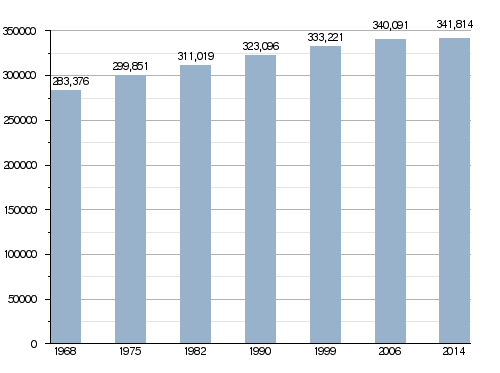
Major Cities in Yonne
Here are the cities in the department with more than 5,000 people:
| City | Population (2014) |
Arrondissement |
|---|---|---|
| Auxerre | 34,843 | Auxerre |
| Sens | 25,507 | Sens |
| Joigny | 9,672 | Auxerre |
| Avallon | 7,025 | Avallon |
| Migennes | 7,019 | Auxerre |
| Villeneuve-sur-Yonne | 5,352 | Sens |
| Charny Orée de Puisaye | 5,145 | Auxerre |
Gallery
-
Sens on the Yonne river
Related pages
Images for kids
See also
 In Spanish: Yonne para niños
In Spanish: Yonne para niños




